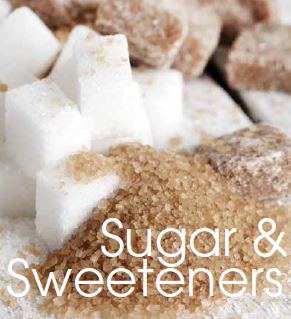As a nutritionist, I am often asked about sugar and artificial sweeteners:
- How much sugar can I have in a day?
- Are artificial sweeteners safe?
- Are sugar substitutes better than sugar?
- What about “natural” sweeteners?
 The focus has long been on how bad sugar is for you, particularly after the “Sugar Busters” diet made national headlines about a decade ago. Sugar is always one of the first things I encourage clients to limit, not only for weight management but for better overall health. Sugar is pro-inflammatory (exacerbating many health issues), it wreaks havoc on blood glucose levels and it has zero nutritional value. Alas, what do we do about our sweet tooth?
The focus has long been on how bad sugar is for you, particularly after the “Sugar Busters” diet made national headlines about a decade ago. Sugar is always one of the first things I encourage clients to limit, not only for weight management but for better overall health. Sugar is pro-inflammatory (exacerbating many health issues), it wreaks havoc on blood glucose levels and it has zero nutritional value. Alas, what do we do about our sweet tooth?
Chemically Processed Sweeteners
One of the most effective ways to slash sugar intake is to reduce sweetened food and drinks. There is no magic number, but read labels and look for as little added sugar as possible. Fructose and glucose are natural sugars derived from fruit and starches respectively; however, when they are added to products as a sweetener, they are chemically processed and therefore have the same ill effects as regular sugar. High fructose corn syrup and corn syrup fall under this category.
Sugar Where You Least Expect It
It’s easy to limit obvious sugar sources like candies, cakes, cookies, etc. However, we don’t always realize how much sugar we are getting in, say, our morning vanilla latte. For most, drinking a vanilla latte seems a lot more innocuous than eating cookies, but in fact, a Grande Vanilla Latte from Starbucks packs a whopping 34 grams of sugar. That’s more sugar than can be found in 12 Thin Mint Girl Scout cookies!
Beware of seemingly healthy foods like fruit-flavored yogurt, instant flavored oatmeal and sugary cereals (even supposedly “healthy” cereals can be high in sugar; stay below five to seven grams of sugar per cup). Even though some of these products may be low in calories, they’re not worth it. The surge in blood glucose levels drops shortly after consuming these sugary foods, leaving you hungry soon after.
Sweeten Yourself
What to do if you have a sweet tooth but don’t like the taste of artificial sweeteners? Use real sugar and sweeten your food and drinks yourself. A teaspoon of sugar or a pack of sugar both have only about 16 calories and four grams of sugar, not enough to make or break a weight loss plan. Adding two packs of sugar to your morning coffee is equal to eight grams of sugar, nowhere near the 34 grams you would ingest with a vanilla latte. Most coffee shops even have vanilla powder you can sprinkle on top of your coffee. Cinnamon is also a widely available topping and is great for blood sugar control.
Alternative Sweeteners
Sweeten your unsweetened Greek yogurt with a teaspoon of honey and maybe a little vanilla or almond extract. Try cinnamon on plain oatmeal with a touch of brown sugar. Honey, agave and raw sugar are natural forms of sugar, but keep in mind that they still have calories and can spike blood sugar just like sugar does, so use sparingly. If you crave the sweet taste but still don’t want the extra calories, I like natural sweeteners like Lo Han or Stevia.
Artificial Sweeteners: The Jury is Out
There is a cloud of controversy surrounding this subject and research is mixed. Many studies support the safety of artificial sweeteners, but there are no long-term studies available. Artificial sweeteners are chemically derived and there are studies that claim they can stimulate appetite.
The Bottom Line
To satisfy your sweet tooth without ingesting massive calories, use a little honey, agave, sugar, Lo Han or Stevia. Once you significantly reduce sugar intake, you will find that your cravings will diminish.
